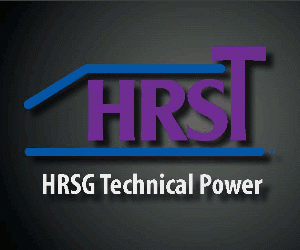Boiler tube leaks have been plaguing fossil-fired powerplants for decades. HRSGs, especially those which cycle frequently, are no exception. Plants experiencing recurring tube leaks should analyze for root cause and make the necessary modifications. If that’s too expensive, another option is to install a sophisticated acoustic monitoring system (AMS) to at least detect leaks earlier, locate them faster, and repair them at the earliest outage opportunity.
This was the situation presented by Tham Chelvan, Siemens Energy, at HRSG Forum 5 (Sept 24, 2021), hosted by Bob Anderson. A 2 × 1 combined cycle at a government-owned plant in South America with V94.3A gas turbines (supplied by Siemens, along with the controls) and triple-pressure, natural-circulation, drum-type heat-recovery steam generators began to have serious tube leaks three years after commercial operation began at the end of 2009. Because they were detected late in the game, the leaks caused collateral and expensive damage to adjacent tubes as well.
Although a root cause of the leaks was determined, owners considered the recommended modifications too expensive at $3.5-million. So the plant installed a Mistras AMS system instead for about 15% of that investment. Siemens was unable to identify a system comparable to Mistras, Chelvan told CCJ in a follow up conversation.
Basic idea behind the technology is that noise created by tube leaks (distinguishable from other noises inside the boiler—such as attemperator sprays—using sophisticated signal processing) travels through the exhaust gas, hits the inner liner, causing a sounding rod to vibrate. The sensor converts the vibration energy into electrical signals.
Hundreds of fired boilers and feedwater heaters are equipped with AMS these days, but only 20+ HRSGs serving combined-cycle facilities because of the need to filter out ambient noise generated by the gas turbine. Perhaps this latest success will encourage HRSG manufacturers, EPCs, and/or owner/operators to consider AMS as standard for unit monitoring and diagnostics.
According to Chelvan, the AMS was installed in 2016 on both boilers, and since then has successfully early-detected 10 tube leaks, almost all of them in one unit. Chelvan also told CCJ that this facility isn’t as penalized for tube leaks at the wrong time. However, users in the US have said that, because of penalties assessed to sites not available in markets when they are committed, as well as lost revenue, a Mistras system can pay for itself with the first tube leak detected. Plus, because the data collected by the Mistras system are tracked in the company’s central monitoring center, no additional work is required from a time-challenged plant staff.
Chelvan includes numerous slides showing the AMS equipment, installation of sensors, trends pre- and post-leak, and weld repairs made to the tubes, all required viewing if you are contemplating an AMS. Perhaps of most practical importance is how the sensors (attached to sounding rod wave guides) are arrayed outside the boiler casing and where the amplifier boxes, power boxes, data logger, computer, and monitoring screens are positioned relative to each other (figures). Several slides clearly show how the data are measured, trended, and interpreted.
EPRI touts carbon initiative
A second presentation at the HRSG Forum gave EPRI an opportunity to pitch it’s Low Carbon Resources Initiative (LCRI), billed as an independent assessment of the work going on worldwide to modify gas turbines and duct burners for natural gas/H2/ammonia fuel blends, which could have repercussions for other sub-systems, such as emissions control.





